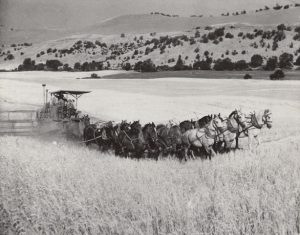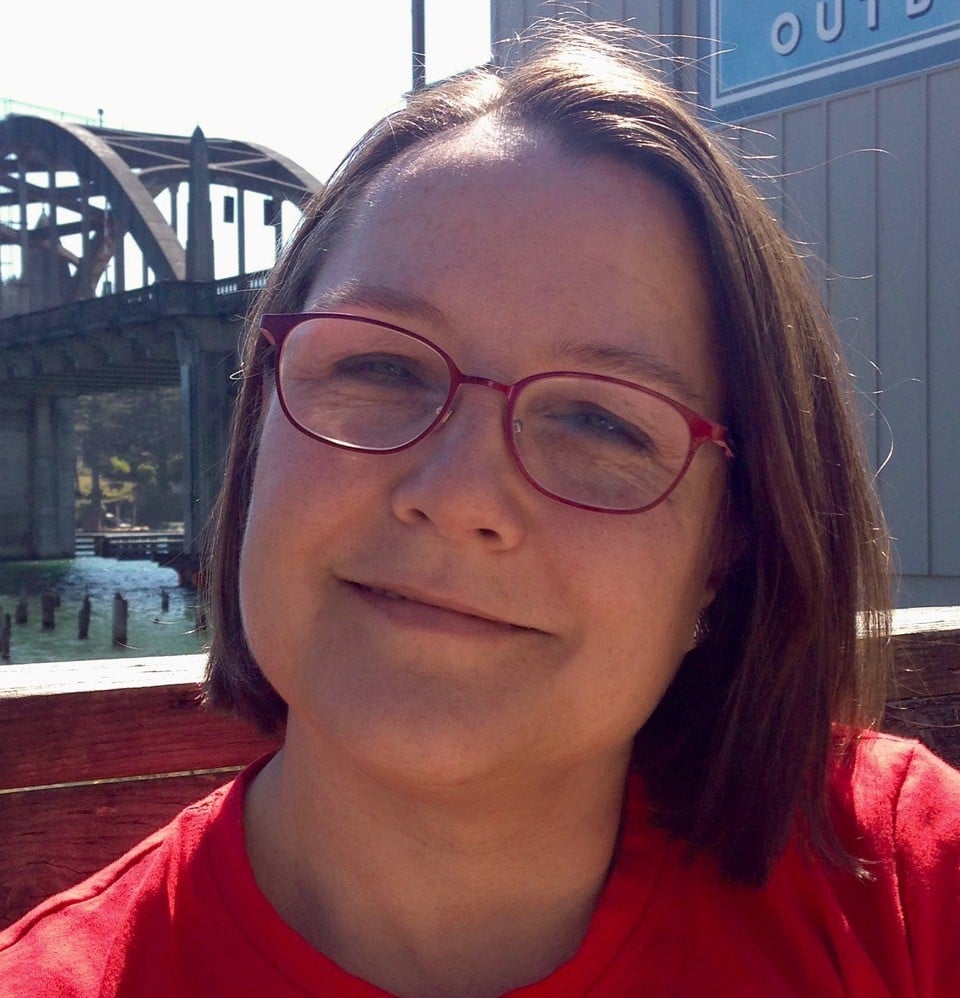 Several years ago my mother gave me a family picture that is unlike most family pictures; in fact, without the identifying information on the back, it doesn’t seem to be a family picture at all. Thank goodness for the label, which gives a ton of information, not only about the location, date, and people, but also about farming practices at the time.
Several years ago my mother gave me a family picture that is unlike most family pictures; in fact, without the identifying information on the back, it doesn’t seem to be a family picture at all. Thank goodness for the label, which gives a ton of information, not only about the location, date, and people, but also about farming practices at the time.
“Harvest at M. C. Kortge ranch, Jap Hollow,[1] 9 miles south of The Dalles, Oregon. Photo taken August, 1938 by Carroll Mundy of St. Joseph, Missouri. Crew: Skinner, High (sic) Marsh; Sewer, J. Ray Kortge; Jigger, “Hack” Haskin; Header Tender, Bill Kortge; Straw Dumper, “Shorty” Caldwell; Machine Man, M. C. Kortge.” But that’s not all! The label also lists all of the horses: “Leaders: Daisy, Fox, Dan; Pointers: Bird, Dick, Baldy, Jerry, Kit, Ginger; Swingers: Tulip, Tom, Bell, Flax, May, Danny; Wheelers: Nuts, Lela, Bonney, Buster.”
Bingo! A relative of some sort.
I’ve been thinking about writing a blog post about this picture for some time, but now became “the time” when a huge fire erupted in this region, which is (as I write this) our nation’s top priority wildfire. In reading about the death of a farmer who was plowing a firebreak to protect his neighbor’s fields, I found a quote from Cynthia Kortge, a friend of the deceased. Bingo! A relative of some sort.[2]
“M. C. Kortge” was my great-grandfather, Mathias Cleveland Kortge, a beloved patriarch whose funeral was the first I ever attended. I was twelve at the time, and I still recall the spray of wheat embroidered on the lining of his coffin, and how there was standing room only in the funeral chapel on that frigid January day. “Pa” (and “Ma”) had been staying at my grandparents’ house in Portland for Christmas when a medical condition suddenly required surgery; sadly, a blood clot went to his heart and he never left the hospital.
Dying at the age of eighty-eight, having lived a productive life and leaving a large family, is probably the least tragic death one can imagine, however much we missed Pa. It was entirely different from the death of his father, which occurred at the age of fifty-two when a horse kicked him in the head. What made even this death in middle age particularly sad was that Friedrich Heinrich Körtge/Koertge left a widow (his fourth wife) who was not quite thirty-six, plus eight children under the age of twelve.[3] My great-grandfather was suddenly “the man of the house” at age eleven.
Dying at the age of eighty-eight, having lived a productive life and leaving a large family, is probably the least tragic death one can imagine...
Pa and all of his siblings were born in Edwards County, Illinois, and his father was my most recent immigrant ancestor, having arrived with his parents and siblings in December 1868 when he was twenty-four. Thankfully the gravestone of his father, Karl Körtge/Koertge, lists the town, Letzlingen in Saxony, where they came from. However, family historians who didn’t speak German believed for many years that the word appearing immediately afterwards, Entschlief, was the region of Germany where Letzlingen is located. It actually means “died,” and is followed by his death date … but one still finds genealogical records with that misinformation. Of course translating foreign words is so much easier in the digital age, but it’s a good lesson in not assuming anything when doing genealogy.
Pa’s closest age brother, Walter, moved to Oregon around 1909. He liked The Dalles so well that he convinced almost all of his siblings to join him; only two sisters died in their native Illinois. In most of my past Vita Brevis posts, I’ve enjoyed sharing discoveries about family connections to exotic places and interesting people. Pa and his family didn’t do fancy things or rub elbows with famous folks. Instead, they represent the bedrock of American society: yeoman farmers – often of immigrant stock – feeding the country and raising their children to be contributing citizens. Not infrequently, like my third cousin’s friend in the news, they are even willing to lay down their lives for a neighbor.
Notes
[1] The name of the location is explained in Lewis A. McArthur’s Oregon Geographic Names: “Japanese Hollow, Wasco County. In 1908 three Japanese, S. Nishizasi, H. Okita and M. Yasui incorporated the Columbia Land and Produce Company. They purchased a sizeable tract of land in what soon became know as Jap Hollow where they raised produce for shipment to The Dalles. In the early 1970s as the United States became more sensitive about the feelings of our minorities, the form was changed to Japanese Hollow.”
[2] I’ve deduced that she is the wife of my third cousin, Jeffrey Michael Kortge, whose existence was unknown to me until now. Ironically, I corresponded with his uncle, Walter Robert Kortge, earlier this year when we got a DNA match through MyHeritage.com … the first match through that source that I could figure out!
[3] One son from his second marriage turned eighteen a few days after his death.
Share this:

About Pamela Athearn Filbert
Pamela Athearn Filbert was born in Berkeley, California, but considers herself a “native Oregonian born in exile,” since her maternal great-great-grandparents arrived via the Oregon Trail, and she herself moved to Oregon well before her second birthday. She met her husband (an actual native Oregonian whose parents lived two blocks from hers in Berkeley) in London, England. She holds a B.A. from the University of Oregon, and has worked as a newsletter and book editor in New York City and Salem, Oregon; she was most recently the college and career program coordinator at her local high school.View all posts by Pamela Athearn Filbert →